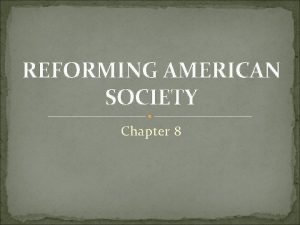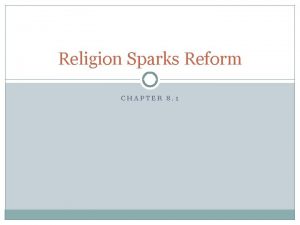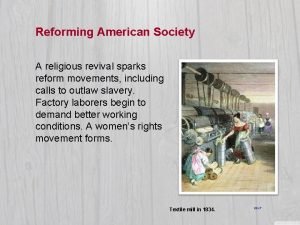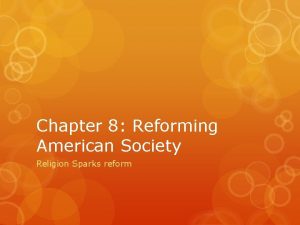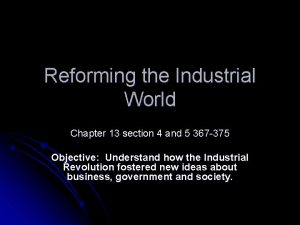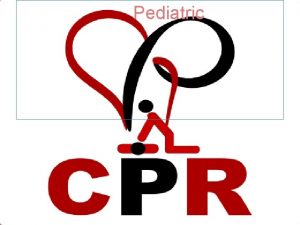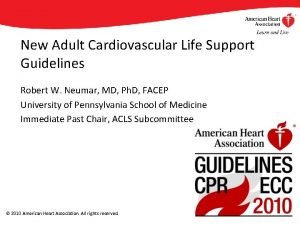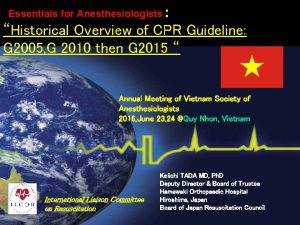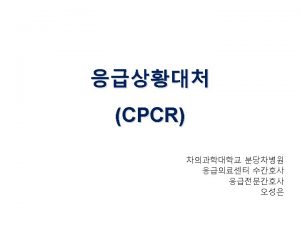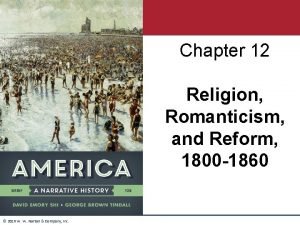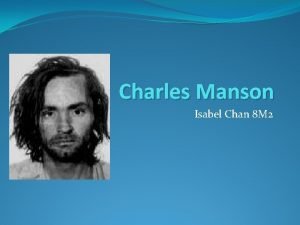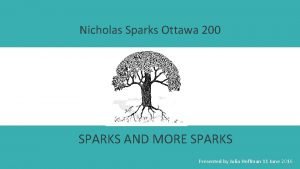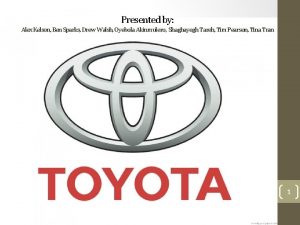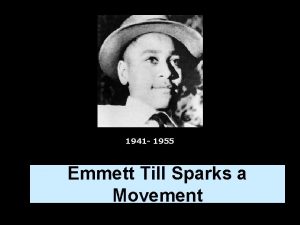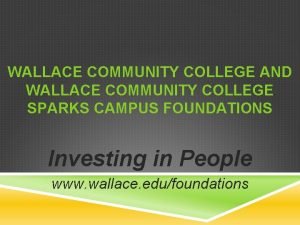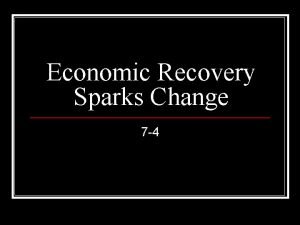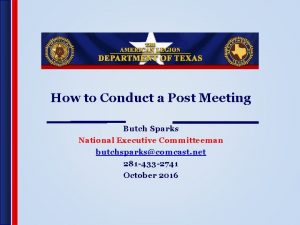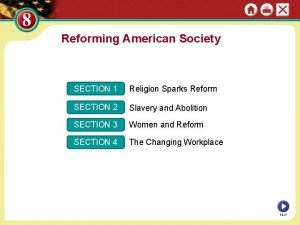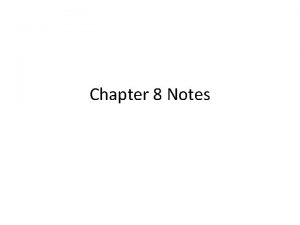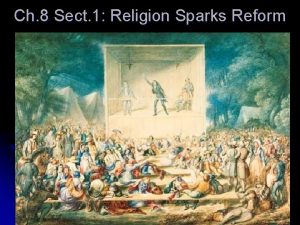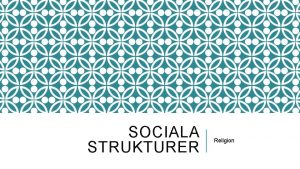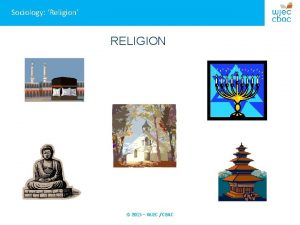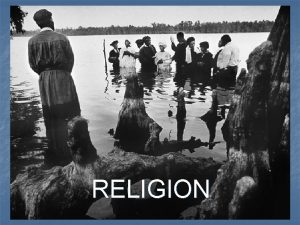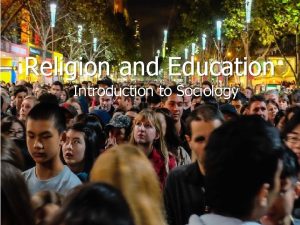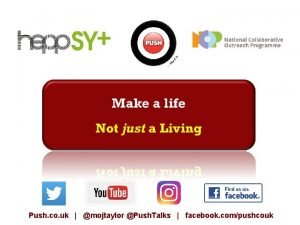A PUSH FOR REFORM Religion Sparks Reform Charles


























- Slides: 26

A PUSH FOR REFORM

Religion Sparks Reform Charles Finney- led a religious movement in the North. � 2 nd Great Awakening- religious movement that encouraged people that their destiny rests in their own hands. � Hard work, living well, and doing God’s work on Earth was promoted. � Reform Era-launched by the 2 nd Great Awakening, was a time in which many Americans attempted to reshape society. (1830 -1860) �


Religion Sparks Reform � Reform Era-launched by the 2 nd Great Awakening, was a time in which many Americans attempted to reshape society. (1830 -1860) � One of the main goals was to reduce the use of alcohol…known as Temperance Movement.

Educational Reform Quality of teaching in common schools was poor. � Horace Mann- greatest educational reformer of era. � Adopted compulsory education. � Adopted use of Normal Schools, or schools where teachers could receive training. � In 1860, 60% of children attended school…almost 2 x the rate of the 1830’s �

Educational Reform � Did nothing for Native or African American children.

Reforming Prisons � Dorothea Dix- campaigned for proper treatment of prisoners and mentally ill. � Nonviolent and violent criminals were housed together in overcrowded cells with unsanitary conditions…many were abused by their jailers. � Her efforts created over 100 treatment centers for the mentally ill.

Transcendentalism and Utopianism Transcendentalism- movement that occurred in New England believed that knowledge is not found only through observation, but also through reason, intuition, and personal spiritual experiences. � Ralph Waldo Emerson- leading transcendentalist that gave lectures and wrote essays describing how people should be self reliant and trust intuition. � One of America’s most renowned authors. �

Transcendentalism and Utopianism � Henry David Thoreau- believed in power of self-reliance and individual thought. � Lived under idea that people should live under their own beliefs and break law if necessary. (tax example) � “government is best which governs least. ”

Transcendentalism and Utopianism � Utopianism- reformers that believed in creating new communities that would be free of social ills. � Utopia- “Perfect Society” � Reformers built more than 90 communities in the Utopian Movement in the 1 st half of the 1800’s.

Early Immigration and Reform Irish Immigration- influenced by the great Irish famine where over 1 million people died by 1850. � Faced with starvation, over 2 million fled to US. � German Immigration- influenced by economic depression, overpopulation, religious persecution, harsh tax laws and military service. � Came in search of free land business opportunites. �


Early Immigration and Reform � Immigrants were often poor and faced discrimination. � sheer numbers, religious beliefs, and cheap labor. � Know-Nothings- Anti-immigrant political group that was a secret fraternal organization. � Germans did not face issues that Irish faced…. Why?

Reform, Urbanization, and Industrialization 1800 – nearly everything was made by hand. � 1860 – 1/3 of all goods made by machine. � Cities began to grow and top 1% controlled half of major city wealth. � Vast majority of Americans were poor and lived in crowded apartments. � 1860 - 1 in 3 worked in factories. � Wage earners and creation of urban working class led to labor movement to fight for better working conditions. �

Women and Reform � Men who spoke out for women were outcasts. � Women were denied many basic rights and could not enter into a legal contract other than marriage. � When divorced, custody of kids awarded to dad. � Not allowed to own property…even household goods.

Women and Reform � Early 1800’s- 60% of factory jobs were held by women…. Why? � Wages of working women was property of husband or family. � Society’s view was women belonged in the home. � 1833 - Oberlin College was first to admit women…. most went to be teachers.

Women and Reform � Seneca Falls Convention- held in 1848 and was the first women’s rights convention held in US. � Elizabeth Cody Stanton and Lucretia Mott organized convention. � Attended by 300 people. � Produced the Declaration of Sentiments signed b 68 women and 32 men stating that all men and women were created equal.


Fight against Slavery � Slavery was an institution for 200 years. � Slaves in all states…but only until 1840’s in North. � By 1860, 4 million slaves in south created an economy based on slaves. � Slaves viewed as property. Purchasing slaves and providing for them was very expensive. � Expected to do whatever was asked.

Fight Against Slavery � Most common job for slave in South was __________. � Other jobs included construction, repair, hauling water, clearing land, cooking, cleaning, factory work, office work, etc. � Rd. paragraph on page 285. � No medical care and no rights. � Many lived in fear with no hope.


Fight Against Slavery Free blacks- played a major role in antislavery activities. � Between 1776 and 1860, 200 slave uprisings occurred in US. � Nat Turner led the deadliest slave revolt in US history. � Turner and 5 slaves killed owner and family, marched through Southampton Co. , VA, gathered 75 followers and killed dozens more white people. �


Fight Against Slavery � Local militia stopped revolt…. Turner and 19 other executed. � Other whites killed over 100 slaves for sympathizing with revolt. � Some slaves tried to escape…estimated between 40, 000 and 100, 000 escaped by 1860.

Fight Against Slavery � Underground Railroad- network of escape routes used by slaves to reach freedom. � Harriet Tubman- most famous worker on Underground RR…she escaped slavery and helped countless others do the same.

Fight Against Slavery Abolition Movement- campaign in the North to end slavery. � Largest movement of the Reform Era…no other movement garnered as much attention. � Deep roots in religion…Quakers did not believe in slavery. � William Lloyd Garrison and Frederick Douglass � Why so serious? ? 55% of exports were cotton �
 Chapter 8 section 1 religion sparks reform
Chapter 8 section 1 religion sparks reform Chapter 8 section 1 religion sparks reform
Chapter 8 section 1 religion sparks reform Chapter 8 section 1 religion sparks reform
Chapter 8 section 1 religion sparks reform Religion sparks reform
Religion sparks reform Chapter 8 section 1 religion sparks reform
Chapter 8 section 1 religion sparks reform Chapter 8 section 1 religion sparks reform
Chapter 8 section 1 religion sparks reform Push hard push fast fully recoil
Push hard push fast fully recoil Push hard push fast fully recoil
Push hard push fast fully recoil Push hard push fast fully recoil
Push hard push fast fully recoil Mild foreign-body airway obstruction
Mild foreign-body airway obstruction Push hard push fast fully recoil
Push hard push fast fully recoil Pea rhythm
Pea rhythm W.w. norton
W.w. norton Western religion vs eastern religion
Western religion vs eastern religion Charles luther manson
Charles luther manson Emma sparks cranfield
Emma sparks cranfield Sparks family tree
Sparks family tree Arcs and sparks
Arcs and sparks Ben eubanks md
Ben eubanks md Felix sparks
Felix sparks Emmett sparks
Emmett sparks Wallace community college sparks campus
Wallace community college sparks campus Economic recovery sparks change
Economic recovery sparks change Sparks nevada police department
Sparks nevada police department Mrs sparks
Mrs sparks By discharging electric sparks into a laboratory
By discharging electric sparks into a laboratory Butch sparks
Butch sparks
